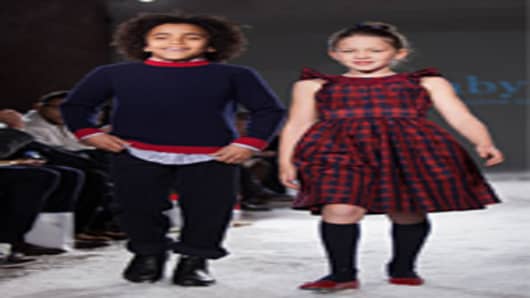The clothes may be small, but designers are betting on big business as they launch childrenswear brands.
On Thursday, Diane von Furstenbergbecame the latest designer to venture into children’s fashion as her signature wrap dresses and prints hit the racks at Gap Kids and Baby Gap in miniature sizes.
Ranging from $20 to $120, the pieces went on sale at U.S. stores today and will be available internationally on March 28.
“Versace, Gucci, Oscar de la Renta — they’re all coming out with their kids’ brands these days and targeting the U.S. market because it is becoming a new trend here as well,” said Gina Rizzo, co-founder of Petite Parade.
While Europe has traditionally been a popular market for luxury childrenswear, the U.S. is now following suit.
“I think there’s a lot more focus on the children’s market design-wise, especially in this country, which was not that prevalent before,” said Carolina Zapf, who designs the Baby CZ brand. “I mean historically there’s been always a lot from Europe, but out of this country there are wonderful companies that are doing great, innovative things and fun things.”
Zapf was one of 27 designers who presented on Saturday and Sunday during New York Kids Fashion Week, which was presented by Petite Parade and Vogue Bambini.
First launched in September 2010, the showcase went on a brief hiatus as the organizers mulled over the best time to hold it. Its organizers eventually decided to present the show at the same time as the Playtime New Yorkchildrenswear trade show.
In her tenure as Vogue Bambini’s editor-in-chief, Giuliana Parabiago said the children’s fashion market has “completely changed.”
“At the beginning, it was a very classic market,” she said. “Every season — the same collection. Nothing changed — all the same outfits.”
Since designers have begun to enter the market, collections are no longer merely last year’s adult fashions in miniature form, Parabiago said. Now, kids’ collections incorporate their own unique trends also.
“With color and fabrication and detail and design, you can do so much more,” Rizzo said. “Kids love anything that is eye-catching and bold, so I think in that sense, there’s more room to play so to speak with children’s fashion.”
Although the designer brands are focusing on innovation in their collections, at the retail level, consumers can expect to see classic colors, plaid, tweed and corduroy, wrote Lorna Hall, a senior retail analyst at WGSN, in an e-mail.
“At retail, most companies are still playing (it) safe with very commercial prints, colors, themes and silhouettes,” Hall said. “The retailer bucking this trend is J.Crew with bright colorways, fashion-forward silhouettes and fabric developments for Crew Cuts.”
Parents pay a premium for these fashion-forward designer collections. Prices at the show ranged from $30 for a T-shirt to $800 for a jacket, Rizzo said.
Parabiago mentioned that purchasing luxury childrenswear is often a “status symbol” for parents.
“They prefer to spend for the children than for themselves,” she said. “Now, the top spenders pay a lot of attention to childrenswear.”
In addition to the U.S. and Italy, luxury children’s fashion is especially popular in Russia and China, she said. To cater to this trend, Vogue Bambini is written in both English and Italian and has launched apps in Chinese and Russian for parents in emerging markets.
“A lot of the time now, you see parents having kids at an older age so they’re a little bit more further in their careers — a little bit more established — so they have money to spend,” Rizzo said. “Maybe it’s their only child because they’re not planning to have another kid.”
Although faltering consumer confidence and economic downturns can decrease adult retail sales, children’s fashion is not usually not affected as much by adverse conditions, she added.
“Children's fashion — it’s an interesting business because kids are constantly growing so they need clothes as opposed to parents who can say, 'You know what — I’m going to resurrect this. I’m going to bring this back next season and wear it again,’” Rizzo said. “But kids grow out of their clothes. They constantly need new clothes.”
Questions? Comments? Email us at consumernation@cnbc.com. Follow Katie Little on Twitter @katie_little_.




